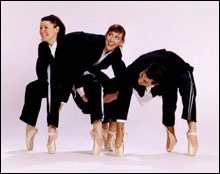The Christmas season careered to a finish January 5 at Concord Academy with yet another Nutcracker, sort of, the first complete Boston performance of David Parker’s Nut/Cracked. Parker and the Bang Group showed sections of the work-in-progress two years ago at Summer Stages, and it’s now evolved into an hour-long extravaganza of dance diversions and visual one-liners with a distant relationship to the perennial ballet. 
Parker dispenses with the ballet’s plot and characters, retaining only trace images of its most cliché’d devices. What does touch off his imagination is Tchaikovsky’s music, or rather a few iconic portions played and replayed via soupy choral arrangements, Ellington, bebop, clickety-clack percussion, and handbells, as well as the symphonic real deal. Anyone saturated with the standard Nutcracker can visualize the dancing Sugar Plum, the Grand Pas de Deux, and the exotic divertissements as the Bang Group are dismantling them.

In a version of the Waltz of the Flowers played by the Glenn Miller band, Kate Digby unrolls a scatter rug of bubble wrap and then skirts its edges for a while, letting the audience savor the possibilities. Finally she throws herself onto it for one satisfying explosion, then goes on to slam and stomp the life out of every bubble with a satisfying orchestration of pops. The same music, played straight, recurs for an ensemble dance, with bouquets handed around and sneezes augmenting the musical climaxes.
Each of the 22 numbers comes with an incongruous prop or costume detail to start a trail of dancing jokes. Three women try to do a Chinese dance but are soon overshadowed by Parker, who appears with a take-out box and a long strand of spaghetti in his mouth. I can’t tell you what the women did, but Parker managed to inhale the last of the spaghetti just as the music ended, and he walked off chewing it. Later, he upstaged the entire company, who were doing a finger-pointing, hip-swiveling dance to the Reed Flutes (Marzipan) music, by teetering across behind them on pointe. They continued dancing but switched their focus en masse, from brazen audience-beguiling smiles to inward gazes.
I think Parker’s point here, and in the whole piece, is to demystify the conventions of ballet. The corps de ballet’s job includes not only negotiating a set of carefully plotted steps but being able to fade into the background when the star appears. In the Grand Pas de Deux, Parker and Jeffrey Kazin parody the kinky mechanics that ballet partners try to conceal as they maneuver into graceful turns and poses, with an orgy of lascivious thumbsucking.
What comes through Parker’s antics is a deep affection for dancers and what they have to go through. The Bang bunch get choreographed into tricky positions and can’t untangle themselves in time, so they dance gallantly on into the music like toads. They wrench into bizarre but artistic group formations. They forget which way to face but they keep doing the steps and hope they don’t collide with anyone.
Kazin and Parker maintain a perpetual rivalry and attraction. Whenever they meet, they begin a co-dependent dance. It could be a side-by-side shuffling tap routine, or a Cubist nightmare of interlocking shapes, or a turf war over a wine glass that ends in a falsetto chorale to the Snowflakes tune. They may need each other, but they’re an uneasy match: Parker, the primo, vain and lordly, capable of making a classically pure attitude pose among his klutzy pointe bourrées; Kazin, the second banana who nevertheless gets to show off his speedy pirouettes and windmill turns at every opportunity.
When the whole troupe finally come out to fling themselves into a series of bows, the audience is in love with them all, Parker, Kazin, Digby, and Cristina Aguirre, Marissa Palley, Nic Petry, Amber Sloan, Emily Tschiffely, Zack Winokur, and Anne Zuemer. On the last note of the coda, they toss celebratory fistfuls of snow into the air.